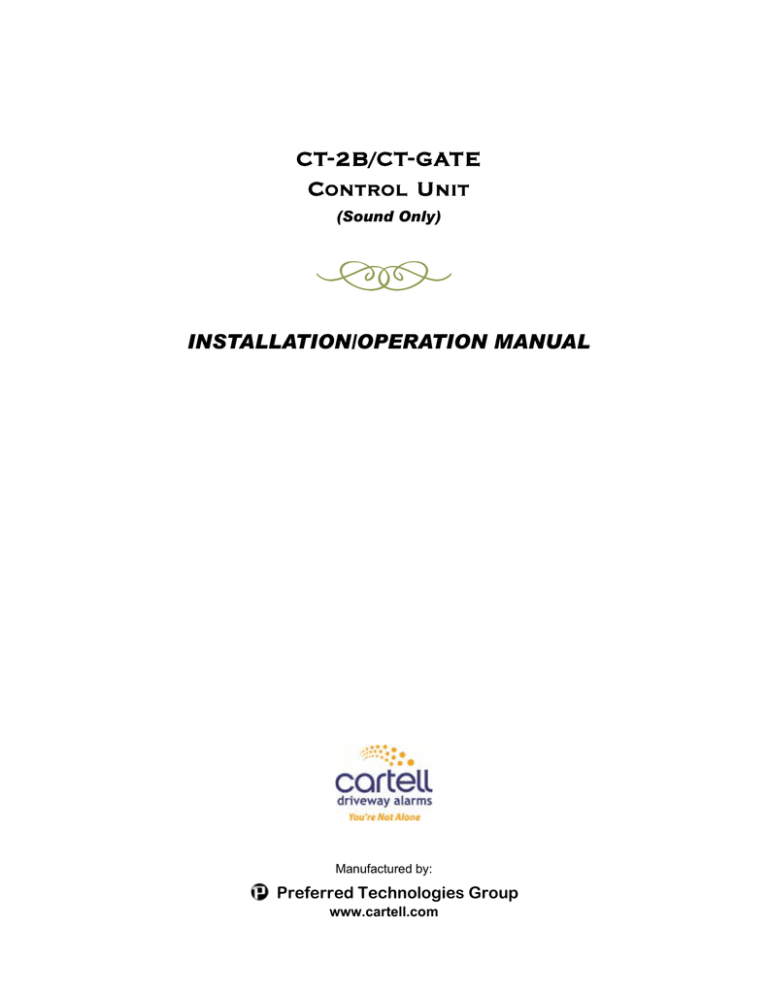Manual: Control unit for Basic™, Integrator™, Pioneer
advertisement

CT-2B/CT-GATE CONTROL UNIT (Sound Only) INSTALLATION/OPERATION MANUAL Manufactured by: Preferred Technologies Group www.cartell.com TABLE OF CONTENTS This Table of Contents is clickable. Point and Click! Introduction.................................................................................. 3 Serial Number.............................................................................. 3 Installing Control Unit .................................................................. 3 Power and Battery Backup .......................................................... 3 Earth Ground ............................................................................... 3 Trip-Test Button .......................................................................... 3 Re-Trigger Hold-Off ..................................................................... 3 Transient Suppression................................................................. 3 Adjusting Sounder (Annunciator) Time........................................ 4 Adjusting Probe Sensitivity .......................................................... 4 Extra Set of Relay Contacts ........................................................ 4 Hooking to a Gate Operator ........................................................ 4 Annunciation in the Home when used with Gate......................... 4 Hooking to a Security or Home Automation System ................... 4 Hooking Up CT-6 Probe to Control Unit ...................................... 4 SD-6 Short Driveway Double-Probe System............................... 5 Field Troubleshooting .................................................................. 5 Warranty Information ................................................................... 5 Merchandise Return Information ................................................. 5 Technical Specifications .............................................................. 5 Copyright © 2010 by Preferred Technologies Group CT-2B & CT-GATE DRIVEWAY SYSTEM MANUAL Note: the CT-GATE is the same as the CT-2B except the circuit board has been conformal coated and therefore suitable for installation outdoors in a weather-proof box or gate operator. Back to Table of Contents INTRODUCTION Congratulations on purchasing the most professional vehicle detection system available! It has been manufactured in order to give years of trouble-free service. However, if it should need servicing, please consult the dealer who installed your system. Read these instructions completely. It is recommended that each system be bench-tested by the dealer before installation as a standard practice. It is also recommended that the installer become acquainted with the CT-2B control unit and sensor probe in the shop; make all adjustments and settings; and study all system functions. If there are any questions or problems that need to be discussed, contact the Preferred’s technical staff. SERIAL NUMBER: Attached to the circuit board relay is a sticker with a set of numbers and letters. This series of numbers and letters reveal the specific unit, its year of manufacture, its issue number and ends with the serial number (see right). When calling Preferred for technical help, please have these numbers handy so that your call may be handled as intelligently and quickly as possible. Back to Table of Contents Back to Table of Contents INSTALLING CONTROL UNIT Install the control unit in a dry, weatherproof building away from heavy electrical motors, radio transmitters, main power service, or any equipment that may introduce electrical or R. F. noise. Install control unit in a sealed box when used in a corrosive atmosphere such as an animal barn or chemical plant. For unheated buildings or other outdoor applications (such as gate operators), use the CT-2BG control unit, as it is conformal coated and not susceptible to moisture caused by temperature changes. However, it should still be installed in a sealed, weather-proof box or in the gate operator. Back to Table of Contents POWER AND BATTERY BACKUP The control unit operates on 12 VAC or 12 VDC. Hook up the 12 VAC transformer as shown in Figure 1. Built-in battery chargers do not come with this system. If battery backup is desired, any 12 VDC power pack can be used. Hook up as shown for 12 VDC operation. Any 12 VDC power source may be used. EARTH-GROUND No grounding is necessary. Back to Table of Contents TRIP-TEST BUTTON See Figure 1. The TRIP-TEST button, located center right on the circuit board, is a tool to evaluate most of the control electronics and to help in setting the relay time. Set the probe sensitivity potentiometer "B" to the halfway point (vertically). Push the trip-test button on and off quickly. DO NOT hold the button on. The signal generated simulates that of a detected vehicle. No response indicates component failure on the circuit board or failure of the power supply or a shorted probe or cable. Disconnect probe wires from terminal strip and try again. Special Note: After using the TRIP TEST button to test the circuit board, wait at least ten seconds before re-testing. This allows time for the re-trigger hold-off timer to reset. Back to Table of Contents RE-TRIGGER HOLD-OFF The new re-trigger hold-off circuit (Issue 3, July 2000 to present) allows both for a shorter annunciator time and minimizes irritating multiple alarms. However, if you are working with an application not conducive to this re-trigger hold-off feature, call Preferred’s technical staff on our 800 number for the disconnect procedure. Back to Table of Contents TRANSIENT SUPPRESSION The CT-2B control unit transient suppressor circuit is already connected. The transient suppressor is activated when the wire is connected to terminal No. 4. This circuit will reduce false alarms caused by lightning. If difficulty occurs when setting the probe sensitivity, disconnect the wire from terminal No. 4 to deactivate the transient suppressor. 3 Back to Table of Contents ADJUSTING SOUNDER (ANNUNCIATOR) TIME See Figure 1 on page 3. This function controls the amount of time the customer desires the noisemaker(s) to stay on. It may be adjusted to stay on anywhere from 2 to 20 seconds (Issues 1,2) or 1/2 to 15 seconds (Issue 3). To adjust, use the potentiometer "A" (CW to increase time). Push the trip-test button to hear your adjustment. Keep adjusting until the desired time is achieved. Back to Table of Contents ADJUSTING PROBE SENSITIVITY See Figure 1 on page 3. Probe sensitivity is set at the factory and does not usually need to be adjusted. Factory setting allows a single standard probe to cover a 12 foot wide driveway when installed beside. Increasing the sensitivity above the factory setting is not recommended unless the probe is located in a low sensitivity area. When the probe is placed in the center of the drive, sensitivity may be decreased considerably allowing the probe to be installed closer to highway traffic, power lines, etc. To adjust probe sensitivity, turn the potentiometer "B" fully counter clockwise and adjust clockwise in small increments. Use a small, slow moving vehicle to test sensitivity. Have it pass the probe and adjust the potentiometer between each pass. Stop adjusting at the point where the small car trips the system each time it passes the probe. Back to Table of Contents EXTRA SET OF RELAY CONTACTS See Figure 1 on page 3. The annunciator relay has a second set of free SPDT contacts that connect to terminals No. 5, 6, and 7. The contacts may be used to trip a dialer, alarm panel, home automation panel, transmitter, X-10 interface module, etc. Back to Table of Contents HOOKING TO A GATE OPERATOR See Figure 1 on page 3. The CT-2BG control unit can be used to trigger a gate operator by using the free set of relay contacts #6 (Common) and #7 (Normally Open). These contacts are to be connected to the momentary input terminals of the gate operator, typically the key pad input or RF radio receiver input. The time adjustment for the relay adjustment "A" should be set at its minimum setting. Longer relay time may be necessary for those installations where the vehicle stops, then restarts near the sensor probe after the gate is open. Back to Table of Contents ANNUNCIATION IN THE HOME WHEN USED WITH GATE In addition to tripping the gate operator, the CT-2BG can be used to trip a sounder inside the home. Run a wire to the gate operator from the home and use the extra set of relay contacts to trip the sounder inside the home. For more information, contact technical support by calling Preferred Technologies Group at 800-2234743. Back to Table of Contents HOOKING TO A SECURITY OR HOME AUTOMATION PANEL See Figure 1 on page 3. You will need two things to have a successful installation: 1. The manual for your home automation or security panel 2. A resistor (consult your manual for the correct size) The CT-2B has a floating, dry relay contact. Note: Use the power supply that came with the CT-2B to power it rather than relying on the home automation or security panel for power. Hook the CT-2B to two zone inputs on your panel. If your system’s contacts are normally closed, use terminals 5 & 6 on the CT-2B. At your system’s panel, place a resistor between the terminals in parallel (see your H.A. manual for resistor size). If your H.A. contacts are normally open, use terminals 6 & 7 on the CT-2B and place a resistor between the terminals in series (see your H.A. manual for resistor size) Back to Table of Contents HOOKING UP CT-6 PROBE TO CONTROL UNIT See Figure 1 on page 3. At the control unit, hook up the RED probe wire to terminal No. 10; connect SHIELD (Drain) wire to terminal No. 11; connect the BLACK wire to terminal No. 12. 4 Back to Table of Contents SD-6 SHORT DRIVEWAY DOUBLE-PROBE SYSTEM The SD-6 double-probe system installation instructions are shipped with the SD-6 double probe set. Only one SD-6 system can be used with the CT-2B control unit. Back to Table of Contents FIELD TROUBLESHOOTING Preferred does not provide circuit diagrams or service manuals. However, we try very hard to provide fast repair service and an 800 number by which technical support may be reached. Before calling Preferred, there are some simple procedures you can follow. The vast majority of all service problems result from a fault with the control unit and not from the sensor probe. Disconnect the probe wires from the control unit and perform resistance tests (as outlined on page 5 of the full CT-2B System Manual). The resistance tests will determine the health of the probe and wire. If the probe reading indicates a bad probe, do not immediately dig it up. Rather, if there is a splice in the line, locate it and cut the wire on the probe side of the splice. Then retest it. If the probe still tests bad, go to the sensor probe itself and cut the wire one foot from the probe and retest it. If the probe still tests bad, then you may need to replace it with a CT-6-10 probe. Splice the CT-6-10 to the cable using the 3-M splice kit (see "Splicing Probe Cable" in the full CT-2B System Manual). To test the CT-2B control unit, do the following: 1. Disconnect the probe wires from the terminal strip; 2. Set the probe sensitivity “B” setting to half way (vertical); and then 3. Push the TRIP TEST button No response indicates possible transformer or power source (across terminals 1 and 2) failure or component failure on the circuit board. If the board does respond, wait at least 10 seconds. Then take a wire and short terminals 10 and 12. If the board does not trip, lightning damage to the probe input to the amplifier is indicated. If either the probe or control unit fails the test, contact the dealer who installed your system. If you are a dealer, call Preferred's technical staff using the 800 number. Further instructions will be given or authorization to return the ostensibly defective product for testing and repair. If the probe is bad there is no way of repairing it. It is recommended that all repairs be returned directly to Preferred and not be sent through a distributor. Back to Table of Contents LIMITED FIVE YEAR WARRANTY All Cartell products are warranted against defects in material and workmanship for five years. This warranty does not cover defects caused by, but not limited to: acts of God, improper installation, abuse, fire and water damage, electrical surges, and damage to cable caused by slicing, pulling, tangling, or improper splicing. For more information, visit www.cartell.com. Back to Table of Contents RETURNING MERCHANDISE Before returning products for repair, please consult the dealer who installed your Cartell system. If he is not available, call Preferred Technologies Group at (800) 223-4743 to receive a Return Merchandise Authorization (R.M.A.) number. Write the R.M.A. number on the return shipping box and any correspondence included with the defective product. TECHNICAL SPECIFICATIONS — CONTROL UNIT Back to Table of Contents POWER REQUIRED: 8-31 VAC; 10-41 VDC (Issue 4) STANDBY CURRENT: Under 1 mA ALARM CURRENT: 45 mA with one sounder (30 mA max. CT-GATE) Double Pole, Double Throw RELAY CONTACT RATING: 1st Pole: 12 VDC, 200 mA for remotes 2nd Pole: SPDT, 5 amps at 30 VDC RELAY TIME: 1/2 to 15 seconds TEMPERATURE RANGE: 0° F - 140° F DIMENSIONS:- complete unit / board only: 5 1/2 in. x 5 1/2 in. x 2 in. / 4 in. x 3 1/4 in. WEIGHT - complete unit / board only: 2.5 lbs. / 1/4 lb. 5 Manufactured by: Preferred Technologies Group www.cartell.com




